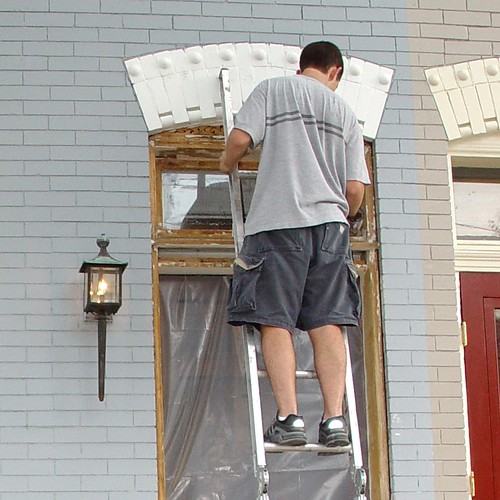Our seemingly endless efforts to strip the paint in our home have led to years of trial and error experiences until we found the tools that really work well for our purposes. Today's Toolbox Tuesday will cover the tools we use that are must haves when stripping layers of old paint.
Yesterday we covered our fortunate salvage yard find of several paint covered doors. We were lucky to find just what we needed. (That rarely happens in a single stop.) However, our find was only the first step in a long restoration process. The doors were covered in flaking and thick layers of paint, and before we would be able to hang and paint the doors, we would need to strip them.
We're actually old pros at paint stripping at this point. We've been stripping paint off of various items in our house since day one -- baseboards, molding, doors, hinges -- just about anything that had thick layers of paint that hid the details or impaired function has been on our lengthy paint removal list. We have our favorite methods and chemicals for paint removal, but the things that actually make the biggest difference in our paint stripping are the tools we use to do it.
General Tools
When I start out on a paint stripping project, I usually try to cover the largest flat surfaces with a few simple tools. A standard 5-in-1 tool is my standby for scraping off chemically stripped paint. If not using chemical stripper, I use a paint stripping heat gun and a 5-in-1 tool to get the majority of the paint off.
There really isn't anything shocking or special about these two items, and they will remove about 80%-90% of the paint you need to remove.
Scraping Tools
When the general tools have reached their maximum effectiveness, we turn to our specialized paint scraping tools. These tools consist of a few small hand tools with various blade profiles to match the flat or intricate details of the surfaces we are stripping. These tools are typically called "pull" type paint scrapers, because as you pull the blades across the paint it pulls up the stubborn paint.
The are two primary types of pull type scrapers: large flat blades and smaller profile blades for intricate details.
We use the large flat blades on surfaces such as the baseboards of flat portions of doors, windows, or molding, These flat blades work alongside chemical strippers, the heat gun, or by themselves. Just be careful that while using it you aren't tearing up the wood by causing "threading." Threading occurs when the scraper begins to tear up the fibers in soft wood.
When you move onto the intricate or smaller details of molding, you can use the interchangeable profile pull type blade scraper. These blades mimic the various curves, beads, and angles that you will typically find on intricate molding and doors.
Dental Tools
The final elements of my stripping arsenal are the pick style tools that resemble what you typically see at the dentist's office. The extremely intricate details that seem to really hold onto paint, such as the groove between fluting or the tiny corners in the detailed elements of doors, require the fine points you have with these tools. Using the dental tools in conjunction with the heat gun work best on the most stubborn detail areas of the wood.
If you stock your paint stripping toolbox with the items I've outlined above, you will be well on your way to stripping almost anything in the house. Like just about any other job around the house, paint stripping requires the right tools and patience.
Do you have any tried and true techniques for paint stripping you'd like to share with us? We're always looking for better ways to improve our process. Let us know if you do.

![]()
![]()